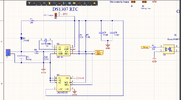Saeedk9574
New Member
Hi everyone,
Whenever I apply voltage from source to the ds1307 RTC it works well but as soon as I connect it to CR2032 battery it gets stuck and Time does not work. I have checked the voltage of battery which is 3v but after resistance the provided voltage on ds1307 IC is about 1.5v. Accordingly, ds1307 needs minimum 2v. This is the circuit schematic diagram I took on the Internet and I did not design it by myself so I suppose the circuit is OK, but I do not know where the problem is.
Whenever I apply voltage from source to the ds1307 RTC it works well but as soon as I connect it to CR2032 battery it gets stuck and Time does not work. I have checked the voltage of battery which is 3v but after resistance the provided voltage on ds1307 IC is about 1.5v. Accordingly, ds1307 needs minimum 2v. This is the circuit schematic diagram I took on the Internet and I did not design it by myself so I suppose the circuit is OK, but I do not know where the problem is.


